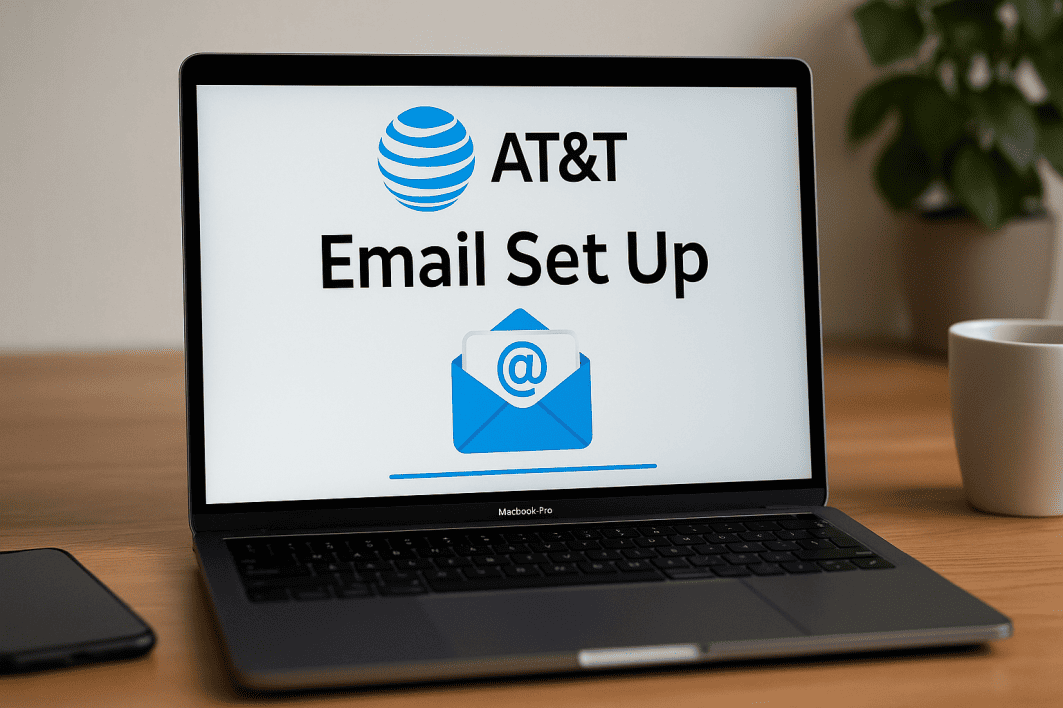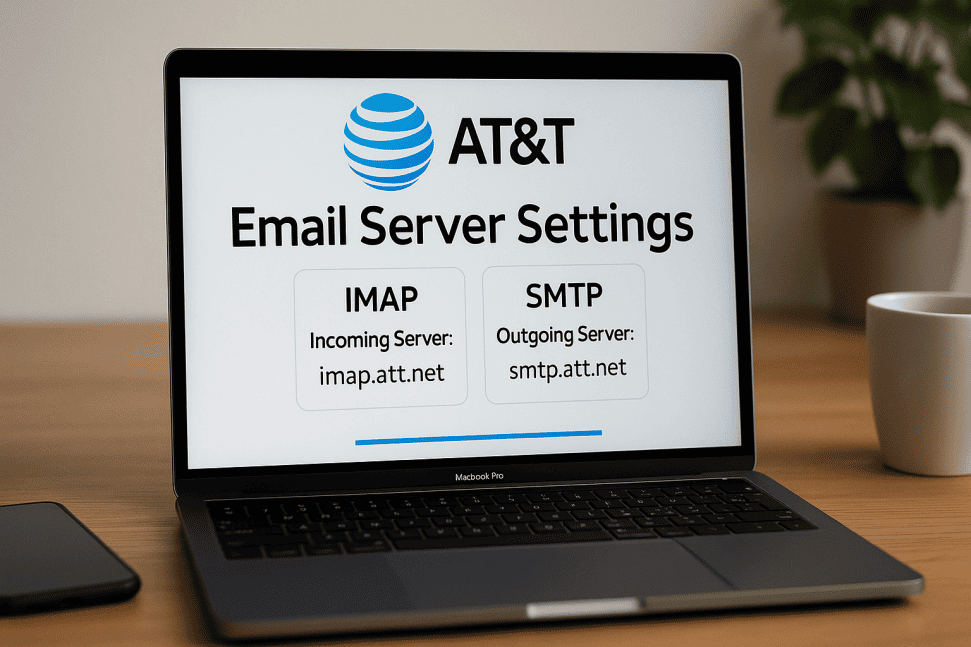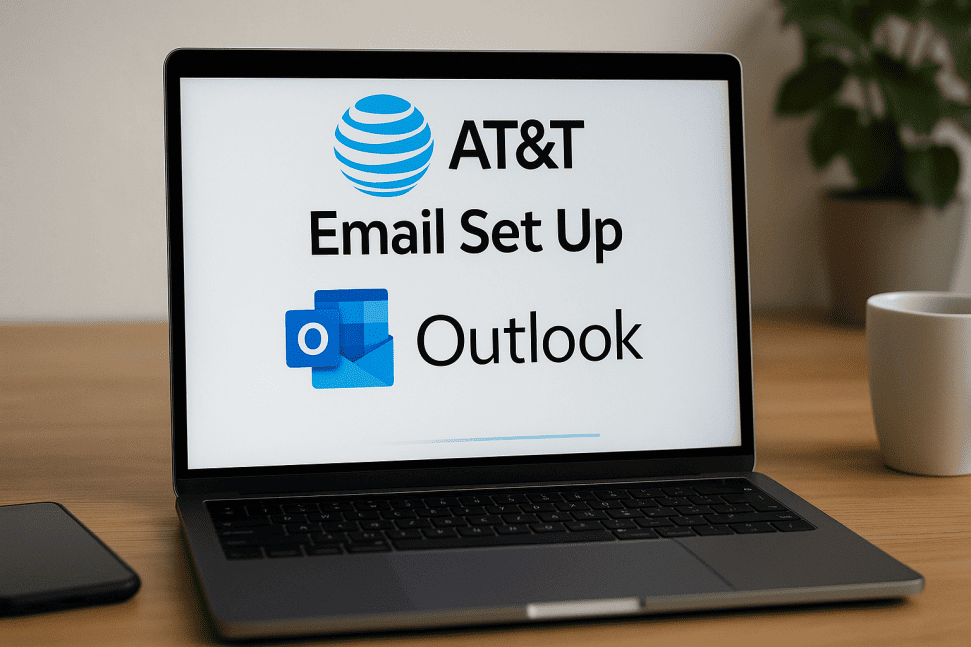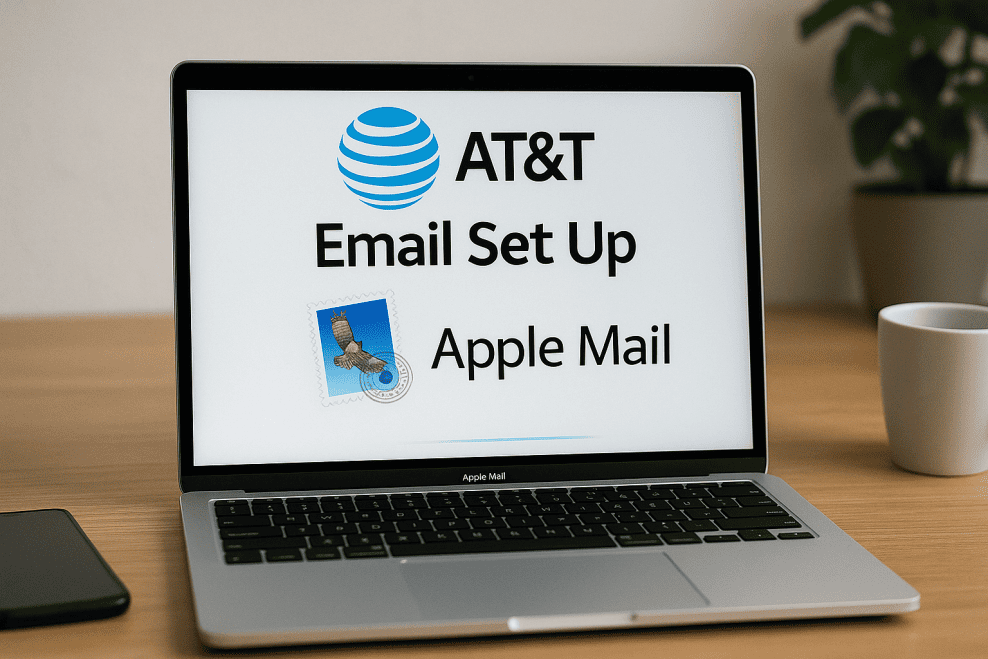ATT Email Set Up
AT&T Mail remains a trusted communication platform for both personal and professional use, thanks to its reliability, security, and compatibility with a wide range of devices. Whether you’re accessing your inbox on a computer, tablet, or smartphone, a smooth att email set up is essential for staying connected. However, many users still face difficulties when entering the correct att mail settings and configuring their accounts across multiple apps and operating systems.

One of the most common challenges involves understanding the proper at&t mail server settings, especially when choosing between IMAP and POP. Users often get confused about the correct at&t email domain, which directly affects how emails are sent and received. When setting up a new device, entering accurate at&t imap settings and smtp becomes crucial to avoid sync errors or login failures.
Those using email clients like Outlook frequently search for updated att mail settings, while mobile users need device-specific configurations. iPhone owners often require precise at&t net email settings for iphone, and Android users depend on compatible details for the att email app. Even small mistakes in the att smtp settings or imap settings can disrupt your entire mailbox.
In this blog, we’ll walk you through everything you need—from understanding AT&T’s server configurations to setting up your account on Windows, Mac, iOS, Android, and Outlook. By the end, you’ll have a complete roadmap for a successful and hassle-free AT&T email setup.
AT&T Email Server Settings
Understanding the correct server configurations is the most important part of a smooth att email set up. Whether you’re using Outlook, Apple Mail, iPhone, Android, or another client, entering the right at&t mail server settings ensures your account syncs properly and delivers emails without errors.

1. Incoming Mail Server Settings (IMAP/POP)
AT&T supports both IMAP and POP, but IMAP is strongly recommended for most users. With IMAP, emails stay synchronized across all devices—ideal for users who access their inbox on phones, laptops, and tablets. The recommended at&t imap settings provide better security, faster sync, and improved compatibility with apps like Outlook, Apple Mail, and for android.
IMAP (Recommended):
- Server: imap.mail.att.net
- Port: 993
- Security: SSL/TLS enabled
These att mail imap settings also support seamless syncing on iOS, especially when applying the at&t net email settings for iphone.
POP (Optional):
- Server: inbound.att.net
- Port: 995
- Security: SSL required
POP is suitable only if you prefer downloading emails to one device, but it is not ideal for modern multi-device workflows.
2. Outgoing Mail Server Settings (SMTP)
For sending emails, the correct att smtp settings are essential. Incorrect outgoing configurations are one of the biggest reasons emails fail to send on Outlook or mobile devices. The official smtp settings for ensure secure and reliable message delivery.
SMTP Settings:
- Server: smtp.mail.att.net
- Port: 465 or 587
- Security: SSL/TLS required
- Authentication: Required
These settings must be entered exactly, especially when configuring att mail settings for outlook or any client relying on the at&t email domain. Proper SSL/TLS encryption guarantees safe transmission of your data, making it an essential step in your overall att mail settings configuration.
ATT Email Set Up on Windows (Outlook, Windows Mail)
Setting up your AT&T account on a Windows device is easy when you use the correct att mail settings and server configurations. Whether you prefer Outlook or the built-in Windows Mail app, entering accurate at&t mail server settings ensures smooth syncing and trouble-free performance. Since many users rely on Windows for daily communication, a proper att email set up is essential for stable and secure access.

1. ATT Email Set up on Outlook (2019, 2021, Microsoft 365)
Outlook remains one of the most popular clients for AT&T users, but it requires precise configuration. Follow the steps below for reliable syncing:
- Open Outlook and go to File > Add Account.
- Enter your full AT&T address using the correct at&t email domain (such as @att.net).
- Select Advanced options and choose Let me set up my account manually.
- Choose IMAP for better multi-device sync using the recommended att mail imap settings.
- Enter the correct at&t imap settings:
- Incoming server: imap.mail.att.net
- Port: 993, SSL enabled
- For outgoing mail, enter the official att smtp settings:
- SMTP server: smtp.mail.att.net
- Port: 465 or 587, SSL/TLS required
- Enter your AT&T password or secure mail key.
- Using a Secure Mail Key: AT&T requires a secure mail key for apps like Outlook that don’t support OAuth. Replace your normal password with this key to ensure proper authentication and prevent issues when sending mail with smtp for att.
2. Setup on Windows Mail App
The Windows Mail app supports both automatic and manual setup. In many cases, entering your email and password initiates auto-detection of the correct att mail settings and similar configurations.
-
Manual Setup Steps:
- Go to Settings > Manage Accounts > Add Account.
- Select Other account (POP/IMAP).
- Enter your email, password, and full IMAP/SMTP details.
-
Troubleshooting Connection Issues:
If syncing fails, double-check your at&t mail server settings, ensure SSL is enabled, and verify firewall permissions. Most issues result from incorrect ports or outdated credentials—especially if you recently updated your password or secure mail key.
While some configurations vary across platforms like the att email app for android or for iphone, the core server settings remain the same, making this process straightforward once entered correctly.
ATT Email Set Up on macOS (Apple Mail)
Setting up AT&T Mail on macOS is a straightforward process when you enter the correct att mail settings and server configurations. Apple Mail supports both automatic and manual setup options, but manually adding the right at&t mail server settings ensures a smoother experience and fewer sync errors. Whether you’re switching from Windows or setting up a new Mac, following the proper steps guarantees a seamless att email set up.

1. Adding Your AT&T Account
To begin, open Apple Mail > Settings > Accounts and choose Add Account. Select Other Mail Account and enter your full AT&T address using the correct at&t email domain (such as @att.net). Apple Mail may attempt to auto-configure the account, but it’s crucial to verify all details, especially the at&t imap settings, before completing the setup.
2. Manually Entering Server Settings
Manual configuration provides the most reliable results. For incoming mail, use the recommended att mail imap settings:
-
- IMAP server: imap.mail.att.net
- Port: 993
- Security: SSL/TLS enabled
For outgoing mail, make sure the att smtp settings match the official configuration:
-
- SMTP server: smtp.mail.att.net
- Port: 465 or 587
- Security: SSL/TLS enabled
- Authentication: Required
These settings are consistent across macOS, iOS, Windows, and even mobile platforms like the att email app for android or for iphone.
3. Fixing Apple Mail Sync Issues
If Apple Mail fails to sync, the issue typically lies in incorrect server ports, outdated passwords, or disabled SSL. Verifying your at&t mail server settings often resolves most errors. Additionally, removing and re-adding the account can help clear cached credentials. By carefully applying the correct settings, you can ensure your AT&T mailbox runs smoothly on any macOS device.
ATT Email Set up on Android Devices
Setting up AT&T Mail on Android is simple when you use the correct att mail settings and server configurations. Whether you’re using a Samsung Galaxy, Google Pixel, Motorola, or any device running Android, following the official at&t mail server settings ensures smooth syncing, stable performance, and secure access. Since Android devices support a wide range of apps—including Gmail, Samsung Email, and the official att email app for android—a proper set up is essential for consistent email delivery.

1. Adding AT&T Mail on Samsung & Pixel Devices
On most Android phones, open the Email or Gmail app, then choose Add Account > Other. Enter your full AT&T email address using the correct at&t email domain (e.g., @att.net). When asked, select IMAP to take advantage of modern syncing capabilities and better device compatibility.
Android will not always auto-detect the required at&t imap settings, so it’s best to enter them manually:
IMAP Settings (Recommended):
-
- Server: imap.mail.att.net
- Port: 993
- Security: SSL/TLS
2. OAuth Support & Secure Mail Key
Many Android apps do not support AT&T’s OAuth authentication. In this case, you must generate a secure mail key through your AT&T account. This key replaces your usual password and prevents login failures, especially when using smtp for att with older apps. While iOS users rely on the at&t net email settings for iphone, Android users must ensure their secure mail key is correctly updated.
3. Outgoing Server (SMTP) Configuration
To send messages, enter the correct att smtp settings:
-
- Server: smtp.mail.att.net
- Port: 465 or 587
- Security: SSL/TLS
- Authentication: Required
These configurations are similar to the att mail settings for outlook, ensuring consistent behavior across platforms.
4. Advanced IMAP Customization
Users can further refine mailbox behavior by adjusting folder sync frequency, enabling push notifications, and customizing outgoing signatures—all dependent on accurate att mail imap settings.
5. Common Android Sync Problems
Typical issues include incorrect ports, disabled SSL, outdated passwords, or cached credentials. Verifying your att mail settings usually resolves syncing failures. Removing and re-adding the account also helps if the device refuses to authenticate.
With the correct settings in place, your AT&T email will run seamlessly across all Android devices.
ATT Email Set up on iPhone & iPad (iOS)
Configuring AT&T Mail on an iPhone or iPad is usually straightforward, but it requires accurate att mail settings and proper authentication to avoid sync problems. iOS devices are known for their strong security features, making it essential to enter the right at&t mail server settings during your att email set up. Whether you’re using a new iPhone, switching from Android, or troubleshooting an error, understanding both automatic and manual setup methods ensures a smooth experience.

-
Automatic vs Manual Configuration
When adding your AT&T account through Settings > Mail > Accounts > Add Account, iOS may attempt automatic configuration. While this works for some users, many still need to enter the correct at&t net email settings for iphone manually to ensure proper syncing.
For manual setup, select Other, enter your full address using the correct at&t email domain (such as @att.net), and proceed to the IMAP/SMTP screen.
-
Enabling SSL, Ports & SMTP Authentication
iOS requires verified secure settings to function properly. Here are the recommended at&t imap settings:
IMAP Incoming Server (Recommended):
-
- Server: imap.mail.att.net
- Port: 993
- Security: SSL/TLS enabled
- Authentication: Password or secure mail key
For outgoing mail, enter the official att smtp settings:
SMTP Outgoing Server:
-
- Server: smtp.mail.att.net
- Port: 465 or 587
- Security: SSL/TLS enabled
- Authentication: Required
These same values apply across platforms, including Outlook, where users need accurate att mail settings for outlook, and Android users using the att email app for android.
-
Error Messages & Fixes
Common iOS errors include “Cannot Verify Server Identity,” “Incorrect Password,” or recurring authentication prompts. Most of these issues stem from incorrect ports, disabled SSL, or outdated credentials. Re-entering your att mail imap settings, regenerating your secure mail key, or removing and re-adding the account typically resolves these problems.
Ensuring the correct at&t mail server settings not only stabilizes your inbox but also improves sending reliability on all iOS devices. With proper configuration, your AT&T email will sync flawlessly across iPhone and iPad.
Security Best Practices for AT&T Email
Keeping your AT&T email secure is just as important as entering the correct att mail settings or configuring the right server settings during your att email set up. Cyber threats continue to evolve, making it essential for users to strengthen account protection across every device—from iPhones to Android phones and even desktop clients like Outlook. Following these best practices helps safeguard your account regardless of the at&t email domain you use.
-
Creating Secure Mail Keys
A secure mail key is a unique password substitute required for email apps that do not support OAuth. Whether you’re configuring att mail settings for outlook, using older Android apps, or entering smtp for att, the secure mail key prevents unauthorized access. Generating this key through your AT&T profile and replacing your regular password in all apps significantly boosts security.
-
Enabling 2-Step Verification
For added protection, enable 2-step verification. This ensures that even if someone obtains your password, they cannot access your account without the verification code. This security step works smoothly across devices, enhancing safety whether you’re using att mail imap settings or syncing your mailbox with the att email app for android or for iphone.
-
Identifying Phishing Emails
Always watch for suspicious emails asking for personal information or login credentials. Phishing scams often imitate official AT&T emails but contain unusual links or attachments. Verifying the sender, avoiding unknown links, and keeping your att smtp settings and security preferences updated helps prevent unauthorized access.
By combining secure mail keys, strong authentication methods, and awareness of phishing attempts, you can maintain a safe and reliable AT&T email experience.
FAQs
Q1. How do I complete my ATT email set up on a new device?
- A. To complete your att email set up, you need to enter the correct att mail settings including IMAP/SMTP details. Once the server settings are added, your device should sync automatically.
Q2. Which AT&T email domain should I use during configuration?
- A. Most users rely on the at&t email domain @att.net, though legacy domains may still work. Always enter the domain exactly as assigned to your account.
Q3. How do I set up AT&T email on an iPhone?
- A. To configure the at&t net email settings for iphone, go to Settings > Mail > Accounts > Add Account and manually enter the IMAP and smtp for att details if automatic verification fails.
Q4. Do I need a secure mail key for all AT&T email configurations?
- A. You only need a secure mail key for apps that do not support OAuth, including some desktop clients and older Android apps. This key works with IMAP and smtp for att authentication.
Q5. What is the difference between IMAP and POP in AT&T mail settings?
- A. IMAP keeps your emails synced across devices using the recommended at&t imap settings, while POP downloads messages to one device only. For most users, IMAP is the better choice for a stable att email set up.
Q6. Do I need to update my AT&T email domain after migrating from Yahoo?
- A. No, your original at&t email domain remains active even after migration. However, you must still apply the correct att mail settings when setting up your account on new devices.
Q7. Can AT&T email be used in third-party apps like Thunderbird or Spark?
- A. Yes, any email client that supports IMAP or SMTP can use AT&T, as long as you enter the correct at&t mail server settings and enable SSL/TLS encryption.
Q8. Why does my AT&T email fail to verify the server during setup?
- A. This usually happens when the at&t mail server settings are incomplete or SSL is disabled. Make sure your ports and smtp for att configuration are entered exactly as required.
Conclusion
Setting up your AT&T email across different devices becomes far easier when you understand the correct att mail settings and know how to apply them on each platform. Whether you’re completing your att email set up on Windows, macOS, iPhone, or Android, the process always starts with entering the proper at&t mail server settings and confirming your account details using the right at&t email domain. These steps ensure your inbox syncs smoothly and your emails send and receive without interruption.
From configuring the recommended at&t imap settings on Apple Mail or on Windows, every device follows the same foundational server requirements. Mobile users also benefit from accurate instructions—whether entering the at&t net email settings for iphone or configuring IMAP for android. Likewise, outgoing mail depends on entering secure and reliable att smtp settings or the correct smtp for att, ensuring your messages are delivered safely.
As you finish setting up your email, remember that configuration is only part of the process. Keeping your account secure is equally important. Generating secure mail keys, enabling two-factor authentication, and staying alert for phishing attempts can protect your AT&T inbox from unauthorized access.
With the right knowledge and the correct att mail imap settings, you can enjoy a seamless, secure, and efficient email experience across all your devices. Whether you’re troubleshooting or starting fresh, following these guidelines ensures that your AT&T email remains dependable and fully optimized.
For more information regarding ATT Mails and other issues and solutions for it, go to our ATT Email Support page.
